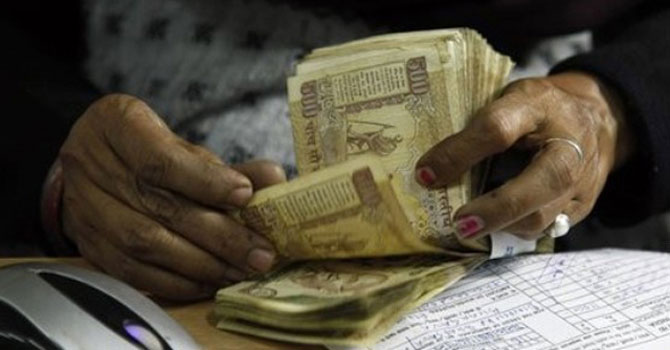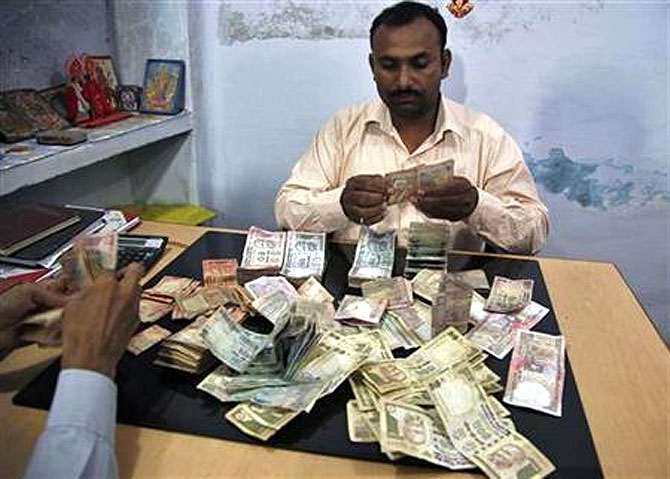Photographs: Reuters A K Bhattacharya
What should have primarily served as an instrument for improving PSU management has over the years become a mere financial exercise to raise revenue to reduce the fiscal deficit, says A K Bhattacharya.
Disinvestment of government-owned shares in public sector undertakings (PSUs), currently a topic of intense discussion within the finance ministry, is not a new idea.
It was mooted as early as 1991, when Yashwant Sinha’s vote-on-account budget in March outlined the importance of the government divesting its equity stake in PSUs.
Later that year, Manmohan Singh, as finance minister, gingerly began work on disinvestment of government shares in selected PSUs.
The National Democratic Alliance government from 1998 to 2004 gave disinvestment a different push by going for privatisation of a few PSUs by selling the government’s majority stake in them in favour of private players.
Disinvestment slowed down considerably in the first term of the United Progressive Alliance (thanks to the political pressure the Left parties succeeded in exerting on the Congress, their alliance partner), but picked up in the UPA’s second term when there was no such pressure from the Left.
…
The trouble with India's disinvestment story
Photographs: Reuters
The total proceeds from disinvestment in the last 22 years are estimated at Rs 1.38 lakh crore. As many as 50 PSUs are listed on the stock exchanges, accounting for about 15 per cent of total market capitalisation of all listed companies.
This number does not include the PSUs that were privatised, such as VSNL, Balco, Maruti Udyog, Hindustan Zinc, CMC, IPCL and a handful of hotel properties owned by India Tourism Development Corporation.
It is important to note that out of the total disinvestment revenue of Rs 1.38 lakh crore, privatisation of these undertakings gave the government less than five per cent, or only about Rs 6,300 crore (Rs 63 billion).
Every financial year invariably begins with the setting of a target of revenue that the government hopes to garner through disinvestment. But the target has been missed in all years except four in this period - 1991-92, 1994-95, 1998-99 and 2003-04.
…
The trouble with India's disinvestment story
Photographs: Reuters
In the current year too, the target of Rs 40,000 crore is all set to be missed, since only about three per cent of that target has been realised so far and only four months of the year are left.
So what has gone wrong with the disinvestment process? Why does every government set a target and then fails to meet it in most years?
To find an answer to these questions, it is necessary to understand the context in which the idea of disinvestment was mooted. Yashwant Sinha’s speech on March 4, 1991, read as follows: “It has been decided that the Government would disinvest up to 20 per cent of its equity in selected public sector undertakings, in favour of mutual funds and financial or investment institutions in the public sector. This disinvestment, which would broad-base the equity, improve management and enhance the availability of resources for these enterprises, is also expected to yield Rs 2,500 crore to the exchequer in 1991-92. The modalities and details of implementing this decision, which are being worked out, would be announced separately.”
Sinha’s plan had two clear goals. One was to widen the equity base of PSUs, improve their management and allow them to raise more resources from the market once they were listed on the stock exchanges.
…
The trouble with India's disinvestment story
Photographs: Reuters
Indeed, the disinvestment exercise has broad-based PSUs’ equity in the last two decades, even though there is doubt if this has consequently led to an improvement in their management or even access to resources.
The second goal was more critical. It was aimed at helping the government augment its revenue flows. Though the annual amount has been small, the government has managed to get a steady flow of additional resources to help it reduce its fiscal deficit over the last several years.
Ironically, it is the second goal of disinvestment that has undermined its first goal that many experts believe was more important and critical for strengthening the public sector.
The government’s concern for disinvestment has, thus, been a reflection of its need to use the share sale proceeds for bringing down its fiscal deficit.
The concern for a more broad-based shareholding pattern of PSUs to help them improve their management response to market challenges has always been given low priority. That is also why disinvestment has over the years become a mere financial exercise to raise some more revenue to reduce the fiscal deficit.
…
The trouble with India's disinvestment story
Photographs: Reuters
If only the International Monetary Fund (IMF) had refused to make an exception in India’s case, the disinvestment story in this country might well have been different.
Tough negotiations had taken place in the early 1990s between the IMF officials and the Indian government on whether disinvestment proceeds could be treated as receipts while measuring the fiscal deficit.
The IMF, which had granted a stand-by loan to India, had insisted that disinvestment proceeds should not be included while calculating the fiscal deficit, since the flow was not a regular stream of revenue. The Indian government, however, negotiated hard and persuaded the IMF to make an exception for India.
If the IMF had not budged, would successive governments have treated the idea of disinvestment as an instrument for making their equity more broad-based and their management more autonomous and responsive to market challenges?
Who knows that would have helped avert the farce that takes place every year in the name of disinvestment!







article